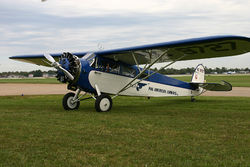Fairchild 71
| Fairchild 71 | |
|---|---|

| |
| Fairchild 71 in RCAF colours | |
| Role | passenger or cargo transport |
| Manufacturer | Fairchild Aircraft Fairchild Aircraft Ltd. (Canada) |
| First flight | 1926 |
| Developed into | Fairchild Super 71 |
The Fairchild 71 was an American high-wing monoplane passenger and cargo aircraft built by Fairchild Aircraft and later built in Canada by Fairchild Aircraft Ltd. (Canada) for both military and civilian use as a rugged bush plane.
Design and development[]
The Fairchild Aircraft Company undertook a progressive development of the Fairchild FC-2W2 light transport. Its first improvement was the FC-2, whose several improvements included slightly swept-back wings; wingspan increased to 50 feet; engine power nearly doubled; and interior changes to improve passenger comfort.
The FC-2 first flew in 1926.
The FC-2W was a further development, featuring:
- Camera bay for vertical aerial photography;
- Low-cut aft windows for oblique aerial photography.
The FC-2 and FC-2W continued the use of fabric-covered welded steel tubing for fuselage and empennage construction, and strut-braced wooden-structure fabric-covered wings.
The FC-2W, later known as the Model 71, was built in the United States between 1928 and 1930. In 1929 Fairchild formed a company in Canada (Fairchild Aircraft Limited) at Longueuil, Quebec in 1929 to support the Canadian operators of Fairchild aircraft. The Canadian company also set up a factory production line for the Model 71, developing a variant for the Canadian military. The Canadian-built aircraft differed from the US version in that all the passenger-comfort features were removed, and the craft were built specifically for aerial photography.[1]


Operational history[]

The United States Army Air Service acquired one Model 71 for evaluation; it was designated XC-8, later redesignated XF-1 and used for photographic work.
Eight more service-test aircraft, designated YF-1 were ordered; all nine were later redesignated C-8.
The Royal Canadian Air Force (RCAF), another major military operator, evaluated the Fairchild 71 in mid-June 1930. Thirty four RCAF F-71s were operated from 1930 to 1946. Along with the earlier FC-2 series, the RCAF F-71 was utilized primarily in the aerial photographic survey role as well as northern transport. In November 1934, the RCAF transferred the FC-71s to the five detachments flying in the amalgamated Maritimes No. 5 (Flying Boat) Squadron at RCAF Station Dartmouth. The squadron flew the FC-71 extensively on anti-smuggling (rum running) and illegal immigration patrols for the Royal Canadian Mounted Police (RCMP).[1]
Most of the Model 71 production ended up in the hands of bush plane operators in Canada and the United States. Civilian operators likewise found the 71 a rugged, reliable and highly useful utility transport, well suited for northern and remote operations.
Variants[]
- Fairchild 71
- Initial production variant
- Fairchild 71A
- Production variant with increased sweep on wings and improved interior
- Fairchild 71C
- Canadian-built version
- Fairchild 71-CM
- Canadian-built version with metal-skinned fuselage
- Fairchild Super 71
- Floatplane version with new fuselage and greater wingspan
- Fairchild 51/71
- Canadian-built version with wings of Model 51 and fuselage of Model 71
United States military designations[]

- XC-8
- One prototype Fairchild 71, later redesignated XF-1 when modified for photo survey.
- YF-1
- Eight service-test aircraft
- C-8
- YF-1 redesignated
- C-8A
- F-1A redesignated
- XF-1
- XC-8 redesignated for photo-survey
- YF-1
- Eight Fairchild 71 aircraft for evaluation with provision for seven passenger seats, later redesignated C-8A.
- F-1A
- Production aircraft (Fairchild 71A), six built later redesignated C-8A.
- J2Q-1
- One Fairchild 71 for evaluation by the United States Navy, redesignated XR2Q-1.
Operators[]
Civilian Operators[]
 Mexico
Mexico
 United States
United States
- Clifford Ball Inc.[3]
- Pacific Alaska Airways[2]
- Pan American Airways[2]
- Pan American-Grace Airways[2]
![]() Saudi Arabia
Saudi Arabia
- California-Arabian Standard Oil Co.[4]
Military operators[]
 Canada
Canada
- Royal Canadian Air Force
 United States
United States
- United States Army Air Corps
- United States Navy
Specifications (Model 71C)[]

Data from Canadian Aircraft Since 1909[5]
General characteristics
- Crew: one
- Capacity: eight
- Length: 35 ft 10.25 in (10.93 m)
- Wingspan: 50 ft 0 in (15.39 m)
- Height: 9 ft 4 in (2.84 m)
- Wing area: 309.6 sq ft (28.76 m2)
- Empty weight: 3,168 lb (1,438 kg)
- Gross weight: 6,000 lb (2,724 kg)
- Powerplant: 1 × Pratt & Whitney Wasp B/C 9-cylinder radial piston , 420 hp (310 kW)
Performance
- Maximum speed: 132 mph (212.4 km/h, 115 kn)
- Cruise speed: 106 mph (170.5 km/h, 92 kn)
- Range: 817 mi (1,314 km, 710 nmi)
- Service ceiling: 11,000 ft (3,353 m)
- Rate of climb: 600 ft/min (3.0 m/s)
See also[]
Related development
Aircraft of comparable role, configuration, and era
- Bellanca CH-300 Pacemaker
- Bellanca CH-400 Skyrocket
- Curtiss Thrush
- Ryan Brougham
- Stinson Detroiter
- Travel Air 6000
Related lists
- List of bush planes
- List of light transport aircraft
- List of aircraft of World War II
References[]
Citations[]
- ^ a b Shearwater Aviation Museum: Aircraft History: Fairchild 71
- ^ a b c d e Selman, Jay. "Pan Am Pioneer". Aeroplane. No. February 2015. Stamford: Key Publishing. pp. 32–37. ISSN 0143-7240.
- ^ Clifford Ball Inc., 1929/30
- ^ "Saudi Aramco World : Aerial "Eye"". archive.aramcoworld.com. Retrieved 2021-07-25.
- ^ Molson and Taylor 1982, p. 314.
Bibliography[]
- Donald, David, ed. The Encyclopedia of World Aircraft. Etobicoke, Ontario, Canada: Prospero Books, 1997. ISBN 1-85605-375-X.
- Milberry, Larry. Aviation In Canada. Toronto: McGraw-Hill Ryerson Ltd., 1979. ISBN 0-07-082778-8.
- Molson, Ken M. and Taylor, Harold A. Canadian Aircraft Since 1909. Stittsville, Ontario: Canada's Wings, Inc., 1982. ISBN 0-920002-11-0.
External links[]
| Wikimedia Commons has media related to Fairchild 71. |
- 1920s United States civil utility aircraft
- Fairchild aircraft
- High-wing aircraft
- Single-engined tractor aircraft
- Aircraft first flown in 1926